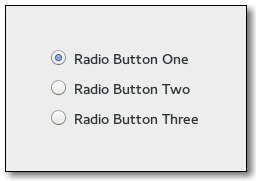RadioButton
Object Hierarchy:
Description:
public class RadioButton : CheckButton, Implementor, Actionable, Activatable, Buildable
A single radio button performs the same basic function as a CheckButton, as its position in the object hierarchy reflects.
It is only when multiple radio buttons are grouped together that they become a different user interface component in their own right.
Every radio button is a member of some group of radio buttons. When one is selected, all other radio buttons in the same group are deselected. A RadioButton is one way of giving the user a choice from many options.
Radio button widgets are created with RadioButton, passing null as the argument if this is the first radio button in a group. In subsequent calls, the group you wish to add this button to should be passed as an argument. Optionally, RadioButton.with_label can be used if you want a text label on the radio button.
Alternatively, when adding widgets to an existing group of radio buttons, use RadioButton.from_widget with a RadioButton that already has a group assigned to it. The convenience function RadioButton.with_label_from_widget is also provided.
To retrieve the group a RadioButton is assigned to, use get_group.
To remove a RadioButton from one group and make it part of a new one, use set_group.
The group list does not need to be freed, as each RadioButton will remove itself and its list item when it is destroyed.
CSS nodes
radiobutton
├── radio
╰── <child>button.radio
├── radio
╰── <child>How to create a group of two radio buttons.
void create_radio_buttons (void) {
GtkWidget *window, *radio1, *radio2, *box, *entry;
window = gtk_window_new (GTK_WINDOW_TOPLEVEL);
box = gtk_box_new (GTK_ORIENTATION_VERTICAL, 2);
gtk_box_set_homogeneous (GTK_BOX (box), TRUE);
// Create a radio button with a GtkEntry widget
radio1 = gtk_radio_button_new (NULL);
entry = gtk_entry_new ();
gtk_container_add (GTK_CONTAINER (radio1), entry);
// Create a radio button with a label
radio2 = gtk_radio_button_new_with_label_from_widget (GTK_RADIO_BUTTON (radio1),
"I’m the second radio button.");
// Pack them into a box, then show all the widgets
gtk_box_pack_start (GTK_BOX (box), radio1);
gtk_box_pack_start (GTK_BOX (box), radio2);
gtk_container_add (GTK_CONTAINER (window), box);
gtk_widget_show_all (window);
return;
}
